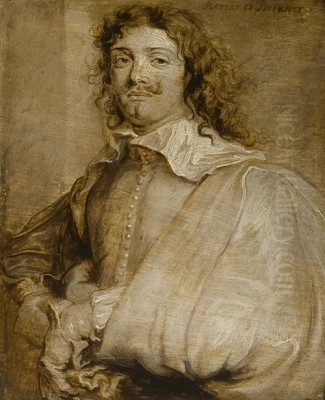
Adriaen Brouwer stands as a pivotal yet enigmatic figure in the art history of the Low Countries during the 17th century. Active primarily in Flanders and the Dutch Republic, Brouwer carved a unique niche for himself with his vivid, often raw, and psychologically penetrating depictions of peasant life, tavern brawls, and intimate scenes of smoking and drinking. Though his life was tragically short, spanning roughly from 1605 to 1638, his innovative approach to genre painting left an indelible mark on his contemporaries and subsequent generations of artists, including giants like Peter Paul Rubens and Rembrandt van Rijn. His work offers an unvarnished look into the everyday existence, vices, and fleeting pleasures of the lower strata of society, rendered with exceptional technical skill and expressive power.
Early Life and Uncertain Beginnings
Pinpointing the exact details of Adriaen Brouwer's early life remains a challenge for art historians, shrouded in the mists of time and conflicting historical accounts. He is generally believed to have been born in Oudenaarde, a town in Flanders (present-day Belgium), around 1605 or 1606. His father, also named Adriaen, worked as a designer of tapestries, a significant industry in Oudenaarde at the time. This familial connection to the visual arts may have provided the initial spark for the young Brouwer's artistic inclinations.
Tragedy struck early when Brouwer's father passed away, possibly around 1621-1622, leaving the teenage Adriaen to forge his own path. It is widely believed that he subsequently moved north, into the Dutch Republic. The details of his whereabouts and training during this formative period are particularly debated. A persistent tradition, largely stemming from the early art historian Arnold Houbraken's "De groote schouburgh der Nederlantsche konstschilders en schilderessen" (1718–1721), places Brouwer in Haarlem as a pupil of the celebrated portraitist Frans Hals.
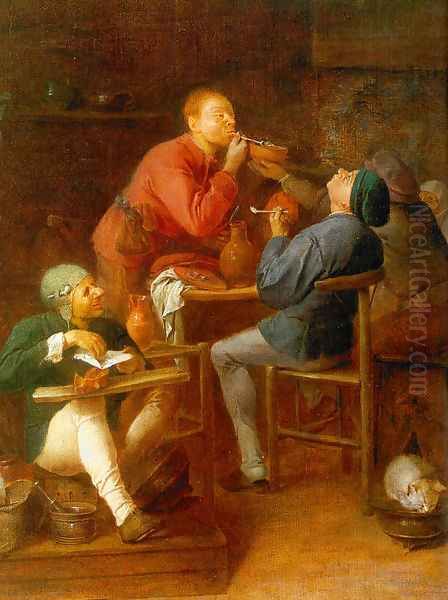
While the stylistic energy and expressive brushwork in Brouwer's later work certainly resonate with Hals's manner, concrete documentary evidence confirming a formal apprenticeship is lacking. Some scholars suggest Brouwer may have worked in Hals's studio or circle, absorbing influences without being a registered pupil. During this period in the Dutch Republic, likely encompassing time in both Haarlem and Amsterdam, Brouwer would have encountered the burgeoning market for genre painting and the work of artists specializing in peasant scenes, potentially including contemporaries like Adriaen van Ostade, who himself was associated with Hals.
Regardless of the specifics of his training, it was during these years in the Dutch Republic that Brouwer likely honed his skills and began developing his characteristic themes and style, focusing on the unidealized portrayal of common folk. His experiences in the bustling towns and taverns of Holland undoubtedly provided rich source material for the works that would later bring him fame.
Antwerp: The Mature Period
Around 1631 or 1632, Adriaen Brouwer relocated to Antwerp, the vibrant artistic capital of Flanders. This move marked a significant turning point in his career. In Antwerp, he was officially registered as a master in the prestigious Guild of Saint Luke, the city's powerful artists' collective. This membership granted him the right to sell his paintings, take on pupils, and fully participate in the city's thriving art market.
His arrival in Antwerp placed him in direct contact with the towering figures of the Flemish Baroque, most notably Peter Paul Rubens and Anthony van Dyck. Despite his focus on 'low-life' subjects, which contrasted sharply with the grand historical and religious canvases favored by Rubens, Brouwer's talent was quickly recognized and highly esteemed by the established masters. His reputation grew rapidly, and his paintings found eager buyers among discerning collectors.
During his Antwerp years, Brouwer seems to have been remarkably productive, creating many of the works for which he is best known today. He became associated with the city's intellectual and artistic circles, frequenting taverns not just for leisure but likely also as an observer, sketching characters and scenes that would populate his canvases. He also joined a local chamber of rhetoric called "De Violieren," suggesting an engagement with the cultural life of the city beyond the confines of his studio.
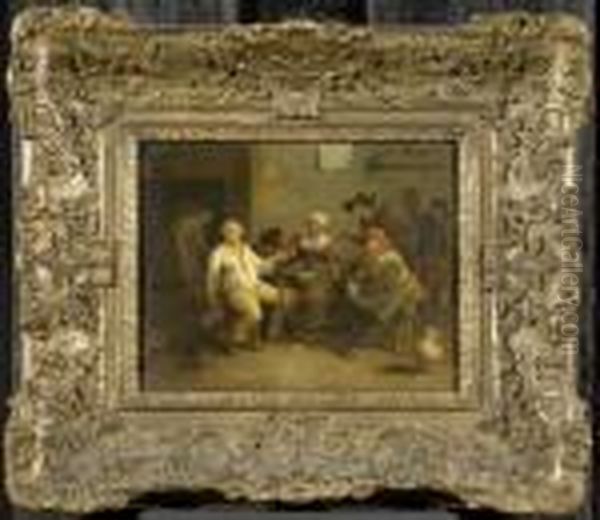
However, this period was also marked by personal turbulence. Records indicate Brouwer accumulated significant debts, a recurring theme throughout his life. His somewhat bohemian lifestyle and perhaps a disregard for financial prudence led to difficulties. Despite these challenges, his artistic output remained strong, characterized by increasing refinement in technique while retaining the raw energy and psychological insight that defined his unique vision. His time in Antwerp, though lasting less than a decade, represents the culmination of his artistic development.
The Unvarnished Lens: Brouwer's Artistic Style
Adriaen Brouwer's art is immediately recognizable for its focus on the unvarnished realities of 17th-century peasant and tavern life. He eschewed the idealized depictions common in some traditions, instead choosing to portray his subjects with a raw, often humorous, and sometimes brutal honesty. His canvases are populated by carousing peasants, gamblers engrossed in their games, smokers lost in contemplation or coughing fits, drinkers raising their jugs, and brawlers settling disputes with fists and furniture.
Technically, Brouwer was a master of his craft. His brushwork is typically energetic, expressive, and visible, contributing to the immediacy and dynamism of his scenes. He applied paint with confidence, sometimes thinly, sometimes in thicker impasto, always adapting his technique to the subject matter. This approach shares an affinity with the painterly style of Frans Hals, lending credence to the idea of at least an indirect influence.
Brouwer possessed an exceptional command of light and shadow (chiaroscuro). He often set his scenes in dimly lit interiors – taverns, rustic cottages, or barns – using focused light sources to highlight key figures and dramatic moments, while allowing surrounding areas to recede into atmospheric shadow. His palette, while often dominated by earthy browns, greys, and greens appropriate to his subjects, could also incorporate surprising touches of vibrant color, particularly in rendering clothing or flushed complexions, adding to the vitality of the scene.
Many of Brouwer's works are relatively small in scale, painted on wooden panels. This intimacy draws the viewer into the scene, encouraging close examination of the details and, crucially, the expressive faces and body language of the figures. Brouwer excelled at capturing fleeting emotions – pain, pleasure, anger, stupor, concentration, mirth – with remarkable acuity. His figures are not mere types but individuals caught in moments of unguarded humanity. This focus on expression connects his work to the genre of "tronies" (character or facial studies), popular in the Low Countries, which explored the range of human physiognomy and emotion. Artists like Rembrandt also famously engaged with this genre.
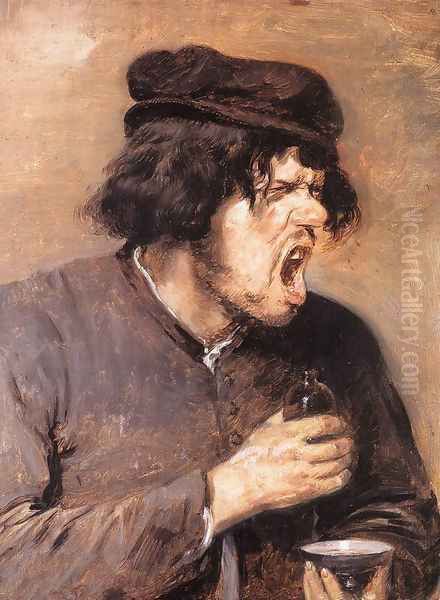
While Pieter Bruegel the Elder had depicted peasant life on a grander scale a generation earlier, Brouwer's approach was more intimate, more focused on the individual and the psychological dynamics within small groups. His work often carries a satirical edge, commenting on human folly and vice, yet it rarely feels overtly moralizing; rather, it presents these slices of life with a sense of detached observation mixed with empathetic understanding.
Masterpieces of the Tavern and Peasant Life
Among Adriaen Brouwer's surviving works, several stand out as quintessential examples of his style and thematic concerns. Perhaps his most famous painting is The Smokers (circa 1636), now housed in the Metropolitan Museum of Art, New York. This small panel depicts a group of men in a tavern indulging in tobacco and drink. The central figure, often identified as a self-portrait of Brouwer himself, stares out at the viewer with eyes wide and smoke billowing from his mouth, a look of intense, almost pained, sensation on his face. His companions exhibit various states of inebriation and reaction to the harsh tobacco of the era. The painting is a tour-de-force of expressive faces, dynamic composition, and rough, energetic brushwork, capturing the raw atmosphere of the tavern.
Another key work exploring tavern life is Interior of a Tavern (also known as A Tavern Scene). Several versions exist, showcasing Brouwer's recurring interest in these settings. These paintings typically depict dimly lit interiors populated by peasants drinking, playing cards, arguing, or sleeping off their indulgence. Brouwer masterfully uses light filtering from a window or candle to illuminate the scene, creating a palpable atmosphere. The figures are rendered with characteristic attention to their varied postures and expressions, conveying a sense of lived reality.
The Bitter Draught (circa 1635), located in the Städel Museum, Frankfurt, exemplifies Brouwer's skill in capturing intense physical reactions. The painting shows a man grimacing dramatically as he consumes a presumably unpleasant medicinal drink, while onlookers react with amusement or indifference. The focus on the contorted facial expression is typical of Brouwer's interest in extreme emotional states and links directly to the tronie tradition.
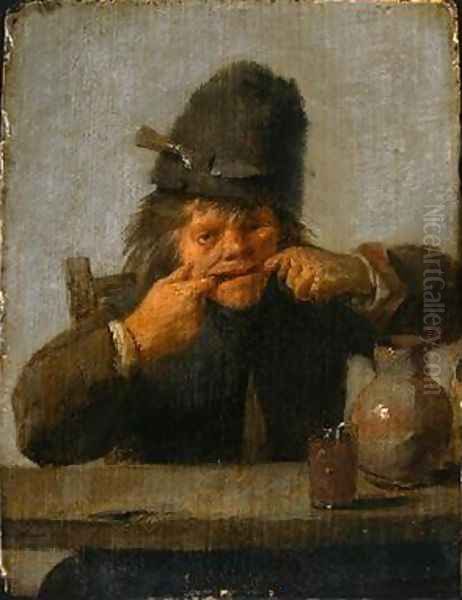
Similarly, works like Youth Making a Face demonstrate his humorous observation of human behavior, capturing a fleeting, playful moment with characteristic immediacy. Other notable paintings depict scenes of brawling peasants, foot surgery (a common theme illustrating pain), and quiet moments of solitary drinking or contemplation. Although the total number of securely attributed works is relatively small (around 60 paintings), their consistent quality and innovative approach solidify Brouwer's reputation. The frequent lack of signatures and dates, however, continues to pose challenges for establishing a precise chronology of his oeuvre.
A Life Lived Intensely: Personality and Anecdotes
The historical record, particularly accounts by early biographers like Arnold Houbraken and Cornelis de Bie, paints a picture of Adriaen Brouwer as a talented but dissolute character, living a bohemian life marked by heavy drinking, tavern frequenting, and chronic financial instability. While such accounts often contain embellishments common in artist biographies of the period, the recurring theme of Brouwer's unruly lifestyle seems grounded in some reality, reflected perhaps in his choice of subject matter and documented debts.
His affinity for taverns was legendary. These establishments were not just places of leisure for Brouwer; they were his primary field of observation, the source of his inspiration, and the settings for many of his most iconic paintings. He reportedly spent much of his time sketching the patrons, capturing their unguarded moments, arguments, and camaraderie. His inclusion of a figure strongly resembling himself in The Smokers suggests a willingness to place himself within the very world he depicted.
His financial troubles were persistent. Despite the high prices his paintings could command and the admiration of prominent collectors like Rubens and Rembrandt (who also owned several of his works), Brouwer seems to have been constantly in debt. This led to legal troubles, including a period of imprisonment in the Citadel of Antwerp around 1633. The exact reasons for his incarceration are unclear – some sources cite unpaid debts, others suggest political reasons related to affiliations with the Dutch Republic during a time of conflict. It was during this imprisonment, according to some accounts, that he befriended the baker and fellow painter Joos van Craesbeeck, who became one of his most devoted followers.

Brouwer's life came to a tragically premature end. He died in Antwerp in January 1638, likely during a plague outbreak that swept through the city. He was only in his early thirties. Initially, he was buried in a common grave. However, according to anecdote, Peter Paul Rubens, deeply respecting Brouwer's talent, arranged for his body to be exhumed and reburied with greater honor in the Carmelite Church in Antwerp, a testament to the high esteem in which the established master held his younger colleague. This short, intense life, lived on the edge and cut down in its prime, adds another layer to the mystique surrounding this exceptional artist.
Esteem Among Giants: Connections and Contemporaries
Despite his focus on humble subjects and his often-unconventional lifestyle, Adriaen Brouwer moved within significant artistic circles and garnered respect from the leading painters of his day. His connections in both the Dutch Republic and Flanders were crucial to his development and reputation.
The most significant connection in Antwerp was undoubtedly with Peter Paul Rubens. The celebrated master of the Flemish Baroque was an avid admirer and collector of Brouwer's work. At the time of Rubens's death in 1640, his estate inventory listed no fewer than seventeen paintings by Brouwer, a substantial number indicating profound appreciation. Rubens reportedly valued Brouwer's painterly skill, his expressive power, and perhaps saw in his raw energy a different facet of the Flemish artistic spirit. This patronage by the most influential artist in Antwerp significantly boosted Brouwer's standing.
Anthony van Dyck, another luminary of the Antwerp school and court painter, also likely knew and respected Brouwer. While direct documentation is scarcer, the close-knit nature of the Antwerp art world makes interaction highly probable. Brouwer's inclusion in Van Dyck's "Iconography," a series of engraved portraits of famous contemporaries, further attests to his recognized status.
Back in the Dutch Republic, the shadow of Frans Hals looms large. Whether as a direct teacher or simply a major influence, Hals's dynamic brushwork and lively characterization find echoes in Brouwer's style. Brouwer, in turn, seems to have significantly impacted artists associated with Hals's circle and the Haarlem school of genre painting.
Adriaen van Ostade, a near-contemporary who also specialized in peasant scenes, shares thematic and stylistic similarities with Brouwer. While early accounts sometimes place them as fellow students under Hals, it is now generally thought that Van Ostade was heavily influenced by Brouwer, particularly after Brouwer's return to Antwerp. Van Ostade's depictions of peasant life, though often less coarse and more gemütlich (cozy or comfortable) than Brouwer's, clearly owe a debt to his innovations. Adriaen's brother, Isack van Ostade, also worked in a similar vein.
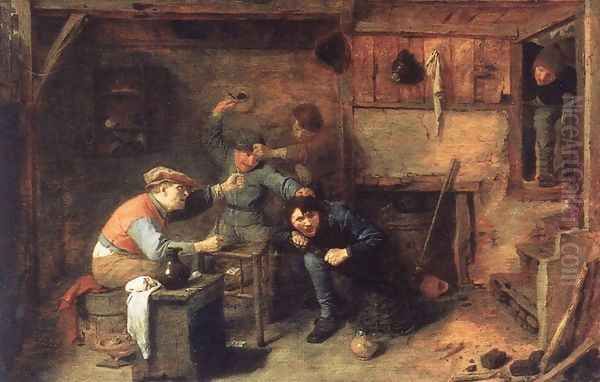
Other contemporaries felt Brouwer's impact. David Teniers the Younger, another major Flemish genre painter who married into the Brueghel family, frequently depicted peasant festivities and tavern scenes. While Teniers developed his own refined style, Brouwer's influence is evident in his choice of themes and occasionally in his more robust characterizations. Joos van Craesbeeck became a close follower, adopting Brouwer's style and subject matter so closely that attributions can sometimes be difficult. Dutch artists like Rembrandt van Rijn not only collected Brouwer's work but may have absorbed aspects of his expressive intensity and chiaroscuro. Later Dutch genre painters like Jan Steen, known for his lively and chaotic domestic scenes, also stand in a tradition shaped partly by Brouwer's pioneering work in depicting everyday life with unflinching realism and psychological depth. Other artists like Cornelis Saftleven and Jan Miense Molenaer also explored similar themes.
Enduring Influence: Brouwer's Legacy
Adriaen Brouwer's career was brief, lasting little more than fifteen years, yet his impact on the development of genre painting in the Low Countries was profound and lasting. He elevated the depiction of 'low-life' subjects from mere anecdotal illustration to a powerful medium for exploring human psychology and social reality. His work demonstrated that scenes of everyday peasant life, taverns, and domestic interiors could possess the same artistic intensity and technical brilliance as more traditionally esteemed subjects like history painting or portraiture.
His most direct influence was felt by his contemporaries and immediate followers in both Flanders and the Dutch Republic. Artists like Adriaen van Ostade and David Teniers the Younger adapted his themes and techniques to their own sensibilities, popularizing peasant and tavern scenes throughout the 17th century. Joos van Craesbeeck dedicated much of his career to working in a style heavily indebted to Brouwer. The sheer number of copies and imitations of Brouwer's work produced during and after his lifetime attests to his popularity and the demand for his particular brand of raw, expressive genre painting. This proliferation of copies, however, also complicates the task of definitively attributing works to Brouwer himself.
Beyond specific followers, Brouwer's broader legacy lies in his contribution to the evolution of realism in Northern European art. His unflinching gaze, his focus on individual expression and emotion, and his mastery of painterly technique provided a compelling model for artists seeking to capture the textures and experiences of everyday life. His exploration of the 'tronie' contributed to a deeper interest in human physiognomy and psychological states.
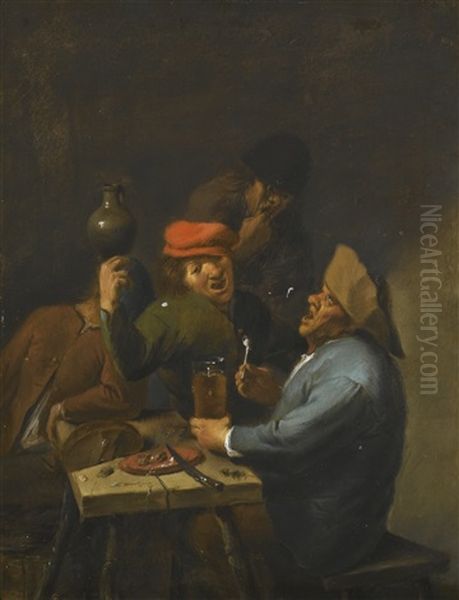
Even though his personal reputation was somewhat colored by tales of his dissolute life, his artistic reputation remained high among connoisseurs. The fact that masters like Rubens and Rembrandt collected his work speaks volumes about his perceived importance. He remains a key figure for understanding the rich diversity of the Flemish and Dutch Golden Age, representing a vital, earthy counterpoint to the grandeur of Rubens or the refined portraiture of Van Dyck. His paintings continue to fascinate viewers with their blend of technical virtuosity, raw energy, and penetrating insight into the human condition.
Conclusion: An Unforgettable Vision
Adriaen Brouwer remains a compelling figure in 17th-century art. Born in Flanders, shaped by experiences in the Dutch Republic, and reaching artistic maturity back in Antwerp, he synthesized influences while forging a unique and powerful style. His depictions of taverns, smokers, drinkers, and brawlers offer an unparalleled window into the less-documented corners of society, rendered with an honesty that could be brutal, humorous, and deeply human all at once.
His technical mastery, particularly his expressive brushwork and dramatic use of light, allowed him to imbue these humble scenes with extraordinary vitality and psychological depth. Despite a short life plagued by instability, his artistic vision was clear and influential. Admired by the greatest masters of his time and emulated by numerous followers, Brouwer secured a lasting place in art history. He stands as a testament to the power of genre painting to transcend mere description and offer profound commentary on the complexities of life, ensuring his work continues to engage and provoke centuries after his death.